소광제
 GENERAL PROPERTIES
GENERAL PROPERTIES
|
WHITENESS | |
|
Every grade has high whiteness. | |
|
FINE PARTICLE | |
|
Nipsil is composed of fine micron particles and does not contain any rough particles. | |
|
PARTICLE SIZE DISTRIBUTION | |
|
Nipsil offers a variety of grades with different particle sizes of which distribution sets in a considerably narrow range. | |
|
WEAK AGGREGATION | |
|
Surface activity is controlled to suppress the aggregation of particles, which enables easy dispersion into variation | |
|
LOW MOISTURE PICK-UP | |
|
The number of exposed silanol groups is controlled to make moisture pick-up as little as possible. | |
|
HIGH OIL ABSORPTION | |
|
Nipsil maintains the nature of amorphous precipitated silica which has high ability to absorb liquid media. | |
|
REFRACTIVE INDEX | |
|
As the RI number of Nipsil (about 1.45) is very close to that of various resins and paints, it guarantees high transparency. | |
|
CHEMICAL STABILITY | |
|
Due to the high purity of Nipsil, it maintains chemical stability except by fluoric acid and strong alkaline chemicals | |
|
SURFACE TREATMENT | |
|
By treating the exposed silanol groups with various chemicals, some grades offer unique properties of anti- precipitation and improved coating surface. | |
|
TOXICITY | |
|
Nipsil is a so-called amorphous high purity silica, being completely different from crystalized silica such as asbestos, and therfore, it can not be the cause of silicosis and does not have any toxic nature | |

 TYPICAL PHYSICAL PROPERTIES
TYPICAL PHYSICAL PROPERTIES
|
GRADES |
pH (4% Susp) |
Bulk density (g/l) |
Specific surface area (㎡/g) |
Oil absorption (ml/100g) |
Average particle size (㎛) |
|
Nipsil E-150J |
6.0-7.5 |
90-130 |
80-100 |
170-220 |
3.5-4.5 |
|
Nipsil E-170 |
6.0-7.5 |
65-95 |
100-120 |
240-265 |
2.5-3.5 |
|
Nipsil E-200 |
6.0-7.5 |
55-75 |
100-130 |
240-260 |
2.5-3.5 |
|
Nipsil E-220 |
6.0-7.5 |
30-50 |
100-130 |
240-260 |
1.0-2.0 |
|
Nipsil E-200A |
6.0-7.5 |
35-55 |
130-155 |
240-260 |
2.0-3.0 |
|
Nipsil E-220A |
6.0-7.5 |
30-45 |
130-155 |
240-260 |
1.0-2.0 |
|
Nipsil K-300 |
5.5-7.0 |
25-40 |
190-220 |
250-280 |
1.5-2.5 |
|
Nipsil E-1009 |
6.0-7.5 |
40-60 |
130-150 |
240-260 |
2.0-3.0 |
|
Nipsil E-1011 |
6.0-7.5 |
25-45 |
130-150 |
240-260 |
1.0-2.0 |
|
Nipsil E-1030 |
6.0-7.5 |
100-130 |
80-100 |
170-220 |
3.5-4.5 |
|
Nipsil ST-4 |
6.0-8.0 |
90-130 |
80-100 |
170-220 |
3.5-4.5 |
|
Nipsil E-75 |
6.0-8.0 |
100-140 |
30-50 |
120-150 |
1.5-2.5 |
|
Nipsil E-150K |
6.0-7.5 |
100-140 |
80-100 |
170-220 |
4.0-5.0 |
|
Nipsil E-743 |
7.0-8.5 |
70-90 |
30-50 |
150-170 |
1.0-1.7 |
|
Nipsil E-74P |
6.0-8.0 |
50-80 |
30-55 |
180-200 |
2.0-3.5 |
|
Nipsil L-250 |
8.0-9.0 |
30-50 |
160-240 |
180-200 |
1.5-2.5 |
|
Nipsil G-300 |
10.0-11.0 |
45-65 |
90-140 |
240-260 |
1.8-2.3 |
|
Nipsil N-300A |
5.5-6.5 |
25-35 |
140-170 |
240-280 |
1.5-2.5 |
|
Nipsil HD |
5.5-6.5 |
15-30 |
240-280 |
230-270 |
1.5-2.5 |
|
Nipsil HD-2 |
6.0-7.5 |
30-60 |
260-330 |
210-260 |
2.5-3.5 |
※Specific surface area : BET method
※Average particle size : Coulter Counter method
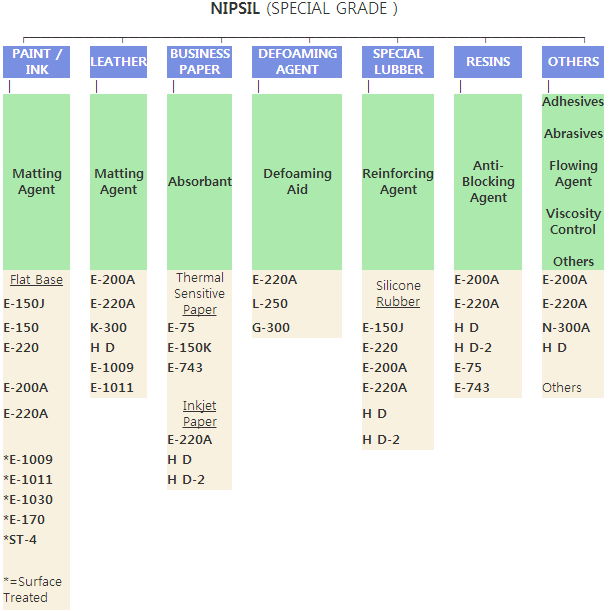
 GRAPHS
GRAPHS
| Ⅰ. Moisture Content | Ⅱ. Flatting Efficiency |
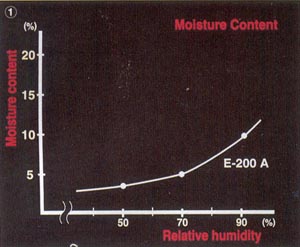 |
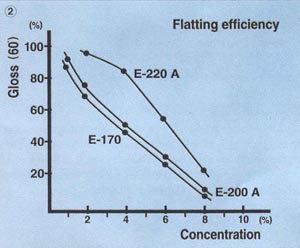 |
| Decrease in weight after heating | Aminoalkyd Clear (Acid Hardner) |
| at 105℃, 2 hours | |
| Ⅲ. Agglomerate Particle Size Distribution Measurement |
Ⅳ. Thermal Gravity |
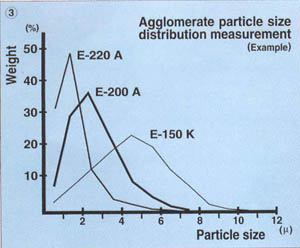 |
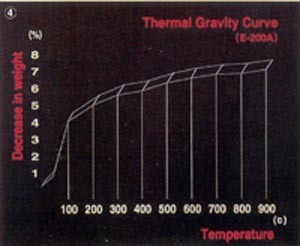 |
| Coulter Counter | Rise in temperature 10℃/min |
| Decrease in weight(%) | |
| =Decrease in weight/sample×100 |




